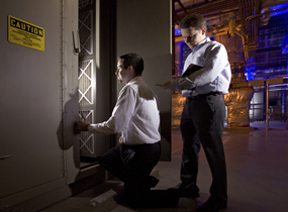
There is no question that facilities where large numbers of people congregate, such as transit centers, shopping malls, and office buildings, are potential targets for chemical and biological attacks. Deploying chemical and biological detectors is a key line of defense in preventing and mitigating such attacks.
For many years, Sandia has worked with BioWatch, other Department of Homeland Security (DHS) programs, and other government agencies to determine the optimum sensor architecture, or sensor siting, for facilities throughout the nation.
Sensor siting is something we all practice when we install smoke and carbon monoxide detectors in our homes. Common sense tells us to install these detectors where fires are likely to occur — in the kitchen — and where we’re most vulnerable to being surprised by a fire — in our bedrooms.
Detecting chemical and biological attacks in large facilities is much more complex. To answer this need, Sandia draws upon years of systems analysis work and the robust capabilities of the Facilities Weapons of Mass Destruction Decision Analysis Center (FacDAC).
“One of the challenges is figuring out what makes a good sensor architecture. We put a lot of effort into ways of measuring performance of architectures to figure out the appropriate metrics,” says Nate Gleason (8125), manager of the advanced systems deployment group. “Detecting the smallest possible release size is not always the right goal. For BioWatch we developed a metric that looks at how many people a release will impact and then designed the system to detect all the releases of a set level of impact, which can be very different in release size.”
The program focuses on three components of an end-to-end approach to facilities protection: countermeasures evaluation, system requirements, and system architecture design. Nate explains that detection must be tied to an action that will mitigate the situation. For example, can the detection system trigger an action that will save lives, such as evacuation?
An inherent problem with real-time sensors is false alarms, so any evaluation of response actions must take this into account. “Given that a sensor has a particular false alarm rate, what action is it possible to take on that sensor alarm? Evacuation wouldn’t be the first action with a real-time sensor” because of that false alarm rate, explains Nate. “So we might consider changing or shutting off airflow or zone isolation.”
Another aspect is the architecture of a sensor system — what types of sensors are deployed, and in what configurations and locations. For example, a system might consist of a large number of inexpensive sensors scattered throughout a facility combined with a few strategically placed, high-capability sensors. An alarm by the inexpensive sensors would trigger the high-capability sensors, thus reducing the likelihood of a false alarm.
There are myriad external factors that must be considered in sensor siting — the number of people in a building, where they are congregated, the weather, when the air filters were last changed, even if a door has been propped open. Coming up with an architecture requires analysis of millions of possible scenarios.
Nate says that tracer testing in Grand Central Terminal early in the program illustrated to the researchers how significant the outside weather can be. A drop in external air temperature of about 15 F caused the air flow through the station to reverse itself from summer to fall.
In a test in another major transportation facility, the airflow was moving in the opposite direction that it should have been, in accordance with the building’s design. The culprit? An employee had propped open a single door in the building.
“It’s easy to design a system that works in one building for a single attack. The goal is to design something that works all the time — that can handle any scenario on any given day,” says Luke Purvis (8114), who now leads the sensor siting program. “Our approach makes our recommendations robust across different building states and attack scenarios.”
To provide this in-depth analysis, Sandia draws upon years of experience in chemical and biological terrorism modeling and systems analysis, beginning with the Program for Response Options & Technology Enhancements for Chemical/Biological Terrorism (PROTECT) in 1997 and continuing with the Protective and Responsive Options for Airport Counter-Terrorism (PROACT) program in 2003.
Five years ago, PROACT began with a model of a boarding concourse of San Francisco International Airport and a simulation of how a single detector would behave in one situation. That capability has evolved to where it is today — the ability to model an entire facility with multiple detector configurations and scenarios.
“How we think about detection and response has really changed,” says Nate. “We’ve gone from detection as the primary goal to targeting the biggest impact release in which detection and immediate response can save the most lives.”
Sandia has sited BioWatch collectors in 15 facilities, some of which are active and operating, and helped develop requirements for the Bioagent Autonomous Networked Detector (BAND) detection system, which is being developed to replace the current BioWatch detectors. Sandia is also siting chemical detectors for a number of unique chemical agents.
Looking forward, Nate says that the biggest challenge is developing metrics. “This is where we are taking advantage of the full FacDAC capability, using moving population models and incorporating actual responses. We’re looking beyond ‘can a detector detect’ and at the value it provides for the goal of saving lives.”
He adds that another goal is to simplify the process, so the analysis doesn’t necessarily have to be conducted by Sandia scientists. “One day we’d like to have a tool that we can hand to a facility engineer to help them protect their building. If chemical or biological detection becomes as ubiquitous as smoke detectors, clearly Sandia can’t site everything.”